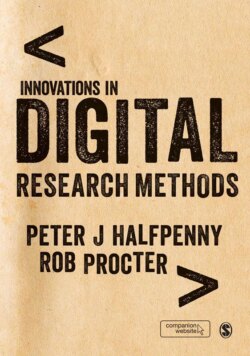Читать книгу Innovations in Digital Research Methods - Группа авторов - Страница 31
На сайте Литреса книга снята с продажи.
1.4.3 Collaboration
Оглавлениеe-Research was conceived from the very beginning as a collaborative activity that would combine the abilities of distributed and complementary groups of researchers in order to achieve research goals that individual researchers or local groups could not hope to accomplish. With this in mind, the concept of the ‘virtual research environment’ (VRE), ‘collaboratory’ (cf. Olson, Zimmerman and Bos, 2008) or ‘gateway’ was another widely promoted element of the e-Research vision. VREs were seen as a way to support collaboration and provide integrated, shared access to resources throughout the research lifecycle, starting with literature searches and ending with the publication of results and curated datasets. In one system, accessible by all team members, a shared bibliography would be assembled. A joint laboratory notebook would be kept which would document all the research procedures undertaken. Data would be stored along with metadata recording the operations it had been subject to, and reports would be written collaboratively, with all versions archived, and publications prepared. Once again, experience has shown that the initial vision had to be tempered. VREs exemplify what happens when ‘top-down’ innovation programmes meet ‘bottom up’ processes through which individuals and groups of researchers experiment with whatever new technologies are at hand. They often prefer to work out their own – often ad-hoc, bespoke but nevertheless effective – solutions that match their needs and level of technical competence rather better than complex, all-embracing offerings whose adoption might lead to having to abandon favoured tools. A prosaic example is the use of an email list and attachments or freeware such as Dropbox10 to share documents, rather than struggle to implement a VRE across different institutions’ computer systems and seek local support in its use. Similarly, Web 2.0 has provided a host of applications that can be easily adopted to support various stages of the research cycle, such as switching from email attachments to an Internet file hosting and synchronizing service like Dropbox or Google Drive. Those VREs that have survived the turbulence of constant technological innovation and rapidly changing standards tend to be associated with ‘big science’ projects, such as climate change, and benefit from long-term funding arrangements.11
